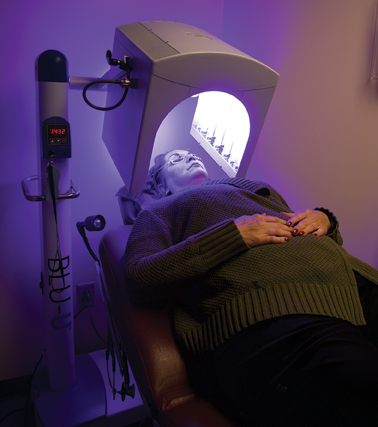What’s a Blu U?
[May 2019 | San Juan Silver Stage | By Kathryn R. Burke]
Image, courtesy ReGenesis Plastic Surgery, Skin Care, and Laser Center in Grand Junction.
I had a Blu-U. And a red face afterward. “What’s that all about?” friends asked me. A couple of them had already done it and knew what I was talking about. The rest were mystified . . . and curious.
A Blu-U is a treatment, sort of like an induced sunburn, used to detect pre-cancerous skin cells. Those of us in the 50+ age group who live at higher altitudes, where we are constantly exposed to the sun, are good candidates for skin cancer. Blu-U can help find and destroy many of the potentially bad cells before they turn into a surgical problem. As an added side effect, it can also improve unsightly skin conditions, like those nasty red or brown ‘age spots’. dry patchy skin, psoriasis, and rosacea. For those of us familiar with the benefits of plastic surgery, you might say it’s a sort of ‘nip’ without the ‘tuck.’
And most insurance pays for it!
I had my Blu-U done at ReGenesis Plastic Surgery, Skin Care, and Laser Center in Grand Junction. (They also have an office in Montrose, but Blu-U is only done at their GJ clinic, where they have the special equipment to do it.)

Blu U treatment machine. Courtesy ReGenesis Plastic Surgery, Skin Care, and Laser Center in Grand Junction.
Also known as photodynamic therapy (PDT), the treatment uses special drugs, called photosensitizing agents, along with light to kill pre-cancer cells—in this case, blue light.
I visited with Dr. Jeff Pitcher at the ReGenesis Montrose office. He explained the procedure, how the treatment works and why. “It’s the most effective pre-cancerous treatment,” he said, “with about 80-85% success rate for pre-cancerous and sun-damaged skin.” It’s non-surgical, done in the office, and is relatively quick and painless, with a short recovery time—usually about 48 hours avoiding direct sunlight or any strong light, such as your computer screen.
A trained technician cleanses the patient’s skin and then applies and aminolevulinic (Levulan®) cream to the surface to be treated. Unless it’s the face, a special plastic wrap is used to cover the treatment area (which allows the cream to penetrate more deeply). After about an hour to let the cream soak in, the patient goes into the treatment area, relaxes comfortably in an adjustable chair, is given eye protection to wear, a small fan to hold, and a headset to listen to music. The blue light is turned on, beaming directly on the treatment area for 16 minutes and 40 seconds.
And that’s it. The technician removes the cream, applies sun block, and the patient is good to go—with follow-up instructions. Avoid direct sunlight for two days. “The medicine stays active, and is still working for about that length of time,” Dr. Pitcher explained. “Use a good moisturizer, wear sunscreen, and make it a lifetime commitment to do so.” (I use a tinted sunscreen, Sundara, which I buy at ReGenesis Montrose Clinic. It’s great. I don’t need makeup any more unless I’m dressing up for a special event.)
And How soon do you see results? In my case, we could see some of the questionable little red spots right away, but they soon peeled away, and the redness was gone in a few days. My skin looked really good. Generally, the doctors want to see you in four to six weeks and, after evaluation, will schedule a second treatment. That usually takes care of things, although many patients, including me, go for the ‘combo’ which is a combination of two Blu-Us, laser, and CO2 treatments. Collectively, this is a more complete treatment modality,” Dr. Pitcher explained, “which, in addition to detecting abnormal pre-cancerous cells and destroying them, also has excellent cosmetic results, helping with wrinkles, patches, and darker pigment spots.”
“Anything that doesn’t go away or still looks suspicious, we will do a biopsy,” he said. “And if that leads to surgery, it can often be performed in the office.”
How long does Blu-U last? That depends on various factors, including skin type, activity level, and lifestyle. Lots of time in the sun engaging in outdoor sports or gardening, for example, means more sun exposure, increasing the risk of skin cancer. Age is another factor—at 50-plus, you’re a more likely candidate. It’s probably a good idea every few years to have a re-evaluation. Just to be safe. And wear your sunscreen.
Speaking as one who has had serious surgery for skin cancer, I hope to never need that again. Since then, I’m grateful for Blu-U, which found a couple places that needed extra attention—taken care of in the office. I’ve made it a habit to wear my sunscreen religiously. But when all else fails, I call for a Blu U—just in case.

